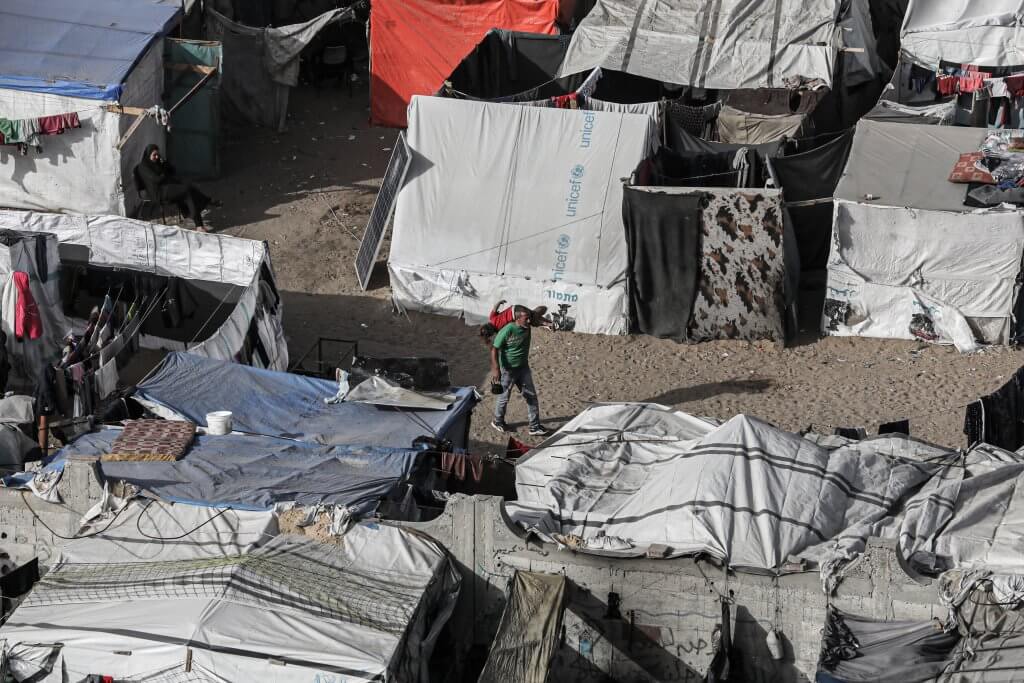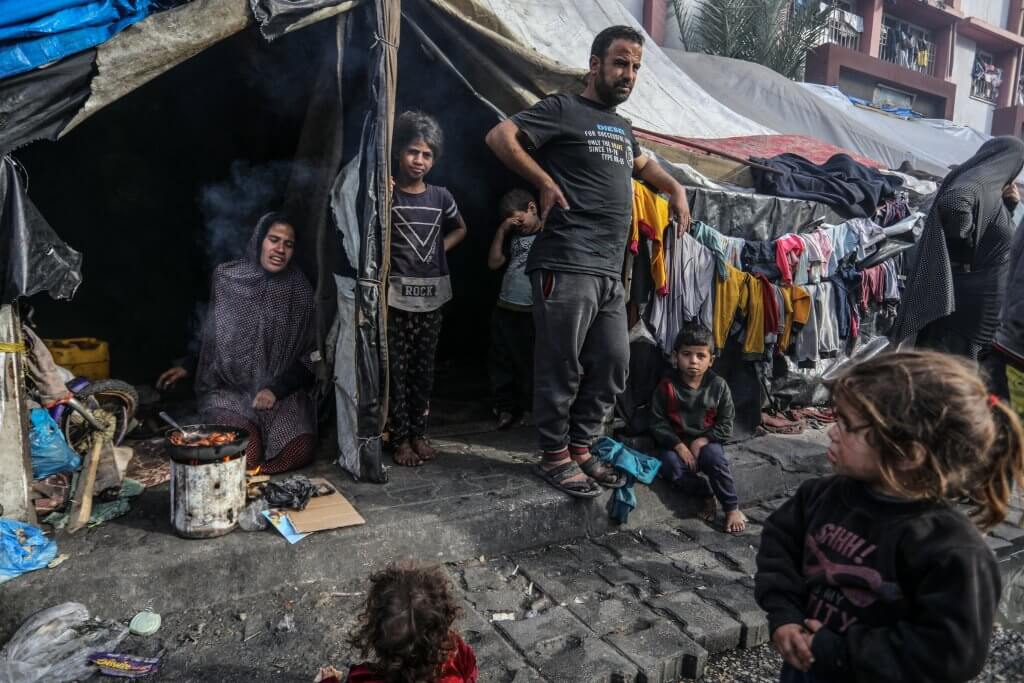It is an unexpectedly hot day in Rafah City. A tent catches on fire in the middle of the camp. The fire spreads quickly, spreading to other tents with the wind. People look on in astonishment or run between the tents in an attempt to put it out. They scream loudly and call for help, but the fire keeps spreading.
Civil Defense crews near the Tal al-Sultan area in Rafah arrive on the scene and put out the fire, but not before it had spread to a few other neighboring tents. A few meters away, Samih al-Nahhala, 48, explains how his tent had been the first to go up in flames.
The minute he and his family had sensed danger, they jumped out and were able to avoid the sudden conflagration, Nahhala says, but they lost all their belongings, or at least all that they owned that had not already been lost since their displacement.
“Using the tent for everything in one place leads to many risks,” al-Nahhala tells Mondoweiss. “Including this fire that broke out as a result of my family’s use of cooking tools near the tent. That’s what caused it.” Behind Samih are the charred remains of a row of several tents.
“These four meters house more than a single family,” he says.
Because there was no space between Samih’s tent and that of his neighbors’ when the fire broke out, the spread of the flames through cloth and nylon was something akin to a wildfire.
Fortunately, the accident led to no casualties, Samih tells Mondoweiss, but they lost all of what little belongings they still owned, forcing them to look for new clothes, pillows, mattresses, and other essentials at a time when all of those things in Gaza were scarce.
In the backdrop to Israel’s brutal war on Gaza, a daily reality weighs heavily on the ability of people to survive. Even after they escaped the bombs, they now have to contend with Gaza’s decimated infrastructure, its collapsing healthcare sector, and the spread of infectious diseases. Coupled with an oppressive heat wave that has taken over Gaza in the past few weeks, these daily realities have made life in Gaza’s displacement camps actively dangerous, creating a new threat that looms before its residents.
Not enough to survive
Flooding sewage passes under the tents of the displaced and on the sidewalks and roads of Rafah. Piles of garbage litter the entrances to school shelters and around displacement camps, attracting flies and insects, which fill tents. Children play barefoot in the sand, mixing with mud, water, and sewage, and transporting germs and microbes to their tightly packed living quarters. In the heat wave, the nylon-covered tents trap in more heat and turn shelters into ovens.
This level of pollution is a direct result of Israel’s deliberate targeting of infrastructure, which has led to the bursting and overflow of sewage wells that pass through crowded places such as Rafah.
Once the sewage flows through these areas, insects follow. Mothers inside tents complain about insects biting their children’s bodies, while the heat and humidity are causing skin diseases and rashes. During the day, flies feast on the piles of garbage, and at night mosquitos descend upon the displacement camps. The next day, children and residents wake up from unexplained itching.
The Gaza Municipality says in its statements that over 270,000 tons of waste are piled up in the streets and in various displacement areas, warning of the environmental disaster that might occur if the waste is not cleared away.
Specialists say that the environmental problems that have arisen during the war are mainly caused by its after-effects, such as the massive destruction of buildings, which creates a severe problem represented by rubble, construction waste, land, air, and water pollution, damage to the electrical network and sewage networks, and surface and groundwater pollution as a result of the massive destruction.

‘This is the occupation’s war objective’
The information published by the government media office in the Gaza Strip indicates that 80% of the buildings in Gaza City have been utterly destroyed and reduced to rubble. In Khan Younis, 61% of buildings have so far been destroyed.
Destroyed houses and the remains of murdered bodies they contain inside them may be one of the reasons for the spread of diseases and disease-carrying insects, according to Dr. Rana Dawoud, an environmental field researcher in Rafah.
“We suffered from high temperatures and climate change and its effects before the war, and we could barely cope with them,” she tells Mondoweiss. “Now, after everything has been destroyed in the Gaza Strip, where there are no resources to help people, where the health situation is deplorable and people suffer from malnutrition…it is too difficult for an ordinary person living in a tent in the Gaza Strip to bear.”
Through her fieldwork, Dr. Dawoud monitors the most critical environmental problems facing the displaced in Gaza. She explains that waste is now nearly four times what it was before the war and has reached a 180% accumulation rate. She notes the increasing danger of the spread of infectious diseases as a result of the continuous pile-up of waste in displacement camps, which is only further compounded by the other environmental factors affecting the strip.
“This is one of the occupation’s war objectives. To make living impossible, and to make the various causes of death of people in Gaza many and numerous.”
Dr. Rana Dawoud
Dr. Dawoud also monitors several open sewage systems next to and under the displacement camps, attempting to track the spread of disease, including skin diseases, gastrointestinal infections, and hepatitis, all of which have become endemic in displacement centers.
Normally, waste collection sites for the Rafah area are located near the eastern border with Israel, but Israel has already bombed those facilities and destroyed the municipal vehicles located there.
“Through my work in displacement centers, I am almost certain that in some camps, everyone in them has been infected with hepatitis,” Dr. Dawoud tells Mondoweiss. “It shows in the symptoms they exhibit, such as the yellowing of the face and eyes, and paleness of the face.”
“Through my work in displacement centers, I am almost certain that in some camps, everyone in them has been infected with hepatitis.”
Dr. Rana Dawoud
She adds that new symptoms have begun to appear in children as a result of insect bites.
“It is known that mosquito bites are easily treated, and their effects disappear after a day or two,” Dr. Dawoud explains. “But insects that bite children in the displacement centers leave effects that last for days, accompanied by complications such as body itching, swelling, skin redness, and even high blood pressure, vomiting, and fever.”
Added to all this, another health hazard has arisen due to the lack of bathrooms. Most camps have dug cesspools for the collection of human waste.
“This waste leaks into the groundwater,” Dr. Dawoud says. “Which the residents of the Gaza Strip depend upon. The digging of these [cesspits] may lead to the partial destruction of water and sewage networks due to random digging.”
“This is one of the occupation’s war objectives,” Dr. Dawoud maintains. “To make living impossible, and to make the various causes of death of people in Gaza many and numerous.”



The Bizarre Gymnastics Of The Gaza Aid Pier
Caitlin Johnstone
May 03, 2024
“So let me get this straight. The US wound up building its “floating pier” a few miles off the coast of Gaza to deliver humanitarian aid, but nobody will be able to ship the aid directly to the pier to get it to Gaza. Instead, the aid will be delivered to Cyprus via air or sea, and then from Cyprus the aid will be shipped 200 miles to the pier. From there the pallets of aid will be loaded onto smaller US army boats, which will then carry the aid from the pier to a long causeway on Gaza’s actual coast. Those pallets will then be carried from the boats to the shore via the causeway — possibly by British troops or possibly by Israeli troops depending on what source you’re reading — and taken into Gaza by IDF troops after careful examination and approval of their contents. All to deliver some 90 to 150 truckloads worth of aid per day, which is far short of the 500 truckloads the UN says Gaza needs.
And this is all being done because Israel isn’t simply letting people drive an adequate amount of aid through the custom-built gates directly into Gaza. Since Washington doesn’t want to exert any pressure on Israel to allow such a self-evident move, this immensely complicated and expensive dance is being performed to deliver a pathetically inadequate amount of aid instead. Aid that is only necessary because Israel has been destroying Gaza in its genocidal bombing campaign which it has been carrying out with total impunity.
Cool. Very normal and cool.”
https://www.caitlinjohnst.one/p/the-bizarre-gymnastics-of-the-gaza
I’ve had heart-breaking appeals from parents keen to get their families out of what remains of “Palestinian Zion”, but I am reluctant to finance ethnic cleansing and leaving the land open to illegal, Israeli-Jewish colonisation. The (mainly US) Christian Zionist-sponsored ethnic cleansing / genocide must be confronted as such, but won’t be. Zionist-influenced media will continue to describe this Crime Against Humanity as a “war” in which those defending their homeland are as guilty as the aggressors / occupiers, and thus “have brought any consequencies on themselves”, (or rather on the innocent). NOTHING justifies Crimes Against Humanity, but until pro-Palestinians are clear about, and campaign on this, it is not going to end and another 100,000 – mainly (or all), innocents – are going to be killed and maimed in southern Gaza and the W Bank including E Jerusalem. We must never accept pro-Zionist euphemisms to describe the situation
Just wondering what happened to my latest post(s) on this thread? Strange indeed!